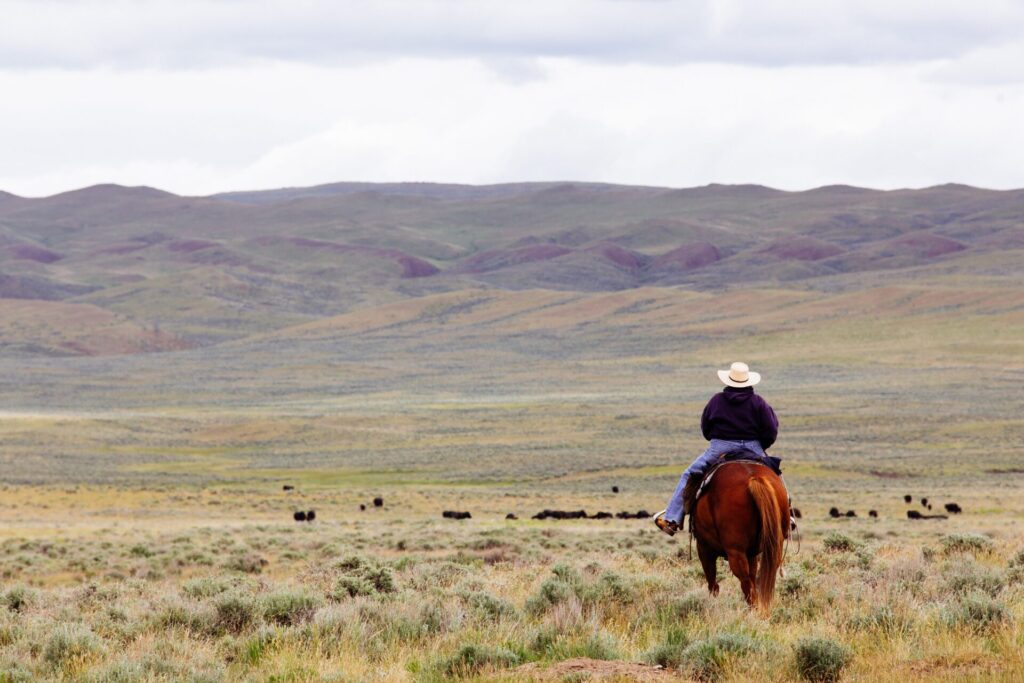CEES research is helping ranchers in Montana find a way to live alongside wildlife

Montana is a beautiful state – the landscape, a haven for biodiversity, is a mosaic of wide-open prairies and valleys set against the backdrop of the Rocky Mountains in the west. But those open spaces aren’t empty land. The state is dotted with over 28,000 working farms and cattle ranches, and livestock are big business. This means that people must find a way to live and work alongside wildlife.
Keeping livestock safe from predators like wolves and bears is crucial to ranch owners. It is also an extremely complex endeavor, involving multiple stakeholders, each with their own social, political, and administrative priorities. Ranchers already use a variety of tools to protect their cattle and sheep, including range riding (being present on horseback while the livestock are grazing), fencing and brightly colored flagging, and scare tactics like alarms and lights. But threats to livestock from predators persist, and wildlife managers are interested in finding new tools to live and work with wildlife.
Wake Forest researchers, led by CEES fellow Jared Beaver (WFU ‘08), are investigating the use of drones as a novel monitoring tool for livestock. Beaver, an Assistant Professor and Extension Wildlife Specialist in Montana State University’s department of animal and range sciences, says the ability to monitor interactions between wildlife and livestock in real time might help mitigate both conflict and disease transmission. In addition to cattle and sheep depredation by bears and wolves, drones can also be used to gather information on the transmission of brucellosis from wild elk to cattle, and of sheep pneumonia between wild and domestic sheep. They could also help wildlife managers detect feral swine, an invasive species moving south into Montana from Canada.
Last summer, four Wake Forest researchers – CEES Director and Andrew Sabin Family Foundation Professor of Conservation Biology Miles Silman, drone specialist Max Messinger (‘13, ‘15), and undergraduate researchers Julia McElhinny (’22) and Sutton Hardy (‘23) – joined Beaver in Montana to test-drive drones for wildlife monitoring. Among other approaches, they flew drones equipped with thermal imaging cameras at night to see how well they could detect elk and other animals through dense tree canopies. The results, shown in the video above, demonstrate the power of thermal imagery combined with typical visual imagery to get a complete picture of the landscape and its inhabitants.
According to Beaver, equipping ranchers and wildlife managers with user-friendly tools and methods to monitor interactions between their livestock and wildlife would enable them to take a more proactive stance against predators and diseases than they currently can. This would be a win-win for agriculture and wildlife conservation. He hopes that the proof-of-concept studies he’s been working on with the Wake Forest team will demonstrate how useful drones can be for wildlife management.
“Wildlife need open, connected landscapes facilitated by both public and private working lands. I haven’t met anyone that wants to live in a concrete world,” says Beaver. “Economically viable working lands build healthier and more resilient connected landscapes, but lands lost to development pose significant challenges for conservation efforts. Thus, if society cares about biodiversity and quality recreational experiences, we need innovative approaches aimed at mitigating wildlife-human conflicts.”
